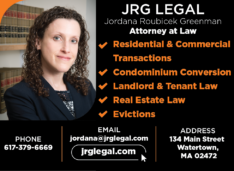Inflation Reduction Act Now in Effect – How Will it Impact Landlords and Housing?
| . Posted in News - 6 Comments
By Eric Weld, MassLandlords, Inc.
The Inflation Reduction Act, a landmark legislative package signed into law by President Joseph Biden on Aug. 6, 2022, includes several tax and other incentives for converting homes and buildings to electric heat pumps and other energy efficiency upgrades.
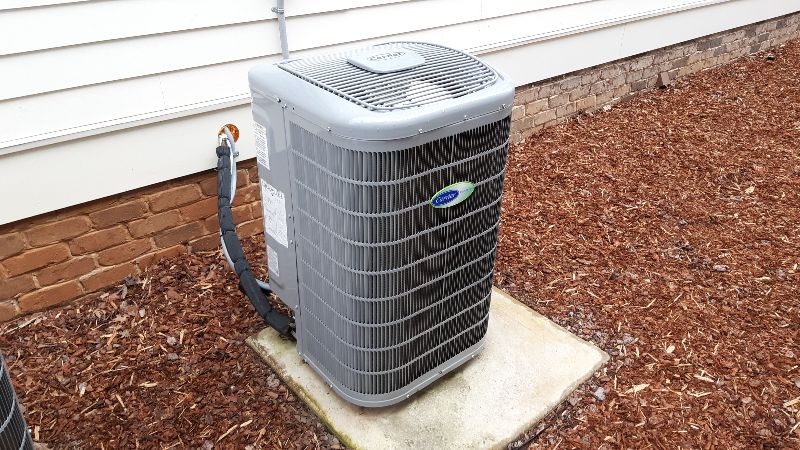
Over the next decade, the Inflation Reduction Act will assist in making air source heat pump units similar to this one a common sight outside homes across the nation. Image: cc by-sa flickr
Landlords could save tens of thousands through these incentives and eventual rebates by converting rentals over the next decade.
While the $740 billion act aims to combat inflation through long- and short-term financial components, some of its most prominent changes will likely have lasting impacts, on health and healthcare, federal tax collection, and housing and homeowners.
Repackaged Build Back Better Act
The Inflation Reduction Act (IRA) is a repackaged and heavily negotiated version of President Biden’s proposed Build Back Better Act, which failed to pass the U.S. Senate. The IRA, which was sponsored by senators Chuck Schumer (D-N.Y.) and Joe Manchin (D-W.V.), was passed through budget reconciliation, a parliamentary procedure that overrides the filibuster and requires only 50 votes in the Senate.
Broadly, the bill aims to fight inflation by reducing the U.S. trade deficit ($300+ billion), lowering energy costs and investing in clean and renewable energy ($369 billion), and expanding Affordable Care Act subsidies for healthcare insurance ($64 billion). The bill will endeavor to raise new revenue by allowing Medicare to negotiate for lower prescription prices ($288 billion), enforcing tax collection by bolstering the Internal Revenue Service budget ($124 billion) and applying a 15% corporate minimum tax ($313 billion).
IRA Extends Two Longstanding Energy Efficiency Tax Credit Programs for Owner-Occupied Rentals
As part of the Inflation Reduction Act (IRA), two longstanding home energy efficiency federal tax credit programs have been extended and increased.

The Internal Revenue Service recently released an FAQ regarding updates to the Inflation Reduction Act that extend two tax incentive programs.
The Energy Efficient Home Improvement credit is a tax incentive program that provides credit for certain energy upgrades, such as high-efficiency heating, cooling and water-heating systems and appliances, and energy-efficient doors and window replacements. The Residential Clean Energy Property credit is a similar tax incentive program that rewards homeowners for making investments in clean and renewable energy.
Details about the program amendments were released by the federal government in December 2022. The Internal Revenue Service (IRS) recently published a fact sheet providing specifics about amounts of credits, qualifying expenditures and eligibilities.
Programs Extended Again, Names and Details Changed
Both these tax credit programs have been around for some time, albeit under slightly different names. In fact, tax credits for residential energy efficiency were first introduced in the 1970s, but expired in 1985. The precursor to the Energy Efficient Home Improvement credit and the Residential Clean Energy Property credit programs were enacted in 2005, as part the federal Energy Policy Act.
The programs were extended in 2009 under the American Recovery and Reinvestment Act.
Both programs have since been extended as sections of larger spending bills and budgets under various titles. Tax credit amounts and percentages have gone up and down through these extension cycles.
For Principal Residences Only
Unlike other provisions in the IRA that provide tax credits, rebates and grants for energy efficiency upgrades to multifamilies, including those not used as principal residences, both of these tax incentives are available only for homes being used as principal residences. Certain energy upgrades to taxpayers’ second homes are eligible for these credits, but “the credits are never available when the improvements are made to homes not used as a residence by the taxpayer,” the IRS FAQ states. It further stipulates, “landlords can never use these credits for improvements made to any homes they rent out but do not use as a residence themselves.”
Still, that’s good news for the tens of thousands of owners of triple-deckers in Massachusetts, who might live in one unit and rent out the other two. Triple-deckers can be difficult and expensive to retrofit for energy efficiency, yet will be a vital part of the state’s push to become carbon neutral by 2050. The tax credits provided in these two programs will give a necessary financial boost to many triple decker owner-landlords to convert to efficient energy.
Also, if a renter wants to make energy efficiency or clean energy upgrades listed under these programs to their rented dwelling (with the owner’s permission, of course), they may qualify for the tax credits, as long as the rental exists within the United States and is used for their primary residence.
Energy Efficient Home Improvement Credits
The IRA extended the Energy Efficient Home Improvement credit beyond 2022 and upped the annual credit amount to $1,200. The program now allows a tax credit equal to 30% of amounts paid by homeowners for qualified expenses for energy-efficient appliance installations, energy improvements and home energy audits.
Specific qualifying expenditures include building envelope components such as exterior doors, windows, skylights and insulation. Home energy audits qualify for a 30% credit of costs up to $150. Installation expenses also qualify for central air, branch circuits and feeders and improvements or replacements of panel boards; as well as natural gas, propane or oil furnaces and water heaters, as long as they satisfy Energy Star efficiency specs. Finally, installations of electric or natural gas heat pumps, heat pump water heaters and biomass stoves and boilers are credited expenses.
Credits are allowed for properties placed in service as of Jan. 1, 2023, and before Jan. 1, 2033.
There is an annual credit limit of $1,200 that applies to building envelope components, home energy audits and energy property. A separate annual limit of $2,000 applies to heat pumps, heat pump water heaters and biomass components. These limits may be combined for a total potential annual credit cap of $3,200.
Residential Clean Energy Property credits
The IRA extends this tax credit program through 2034. It also increased the credit percentages and added battery storage technology investments.
The Residential Clean Energy Property program provides a 30% tax credit for investments of solar panels, solar water heaters, fuel cells, wind turbines, geothermal heat pumps and battery storage systems.
No overall dollar limit applies for this tax incentive. All qualifying expenditures between 2022 through 2032 will be eligible for 30% tax credits. However, fuel cells expenses have a maximum credit of $500 for each half kilowatt of capacity.
The 30% credit on qualifying expenses is allowed for properties placed in service after Dec. 31, 2021, and before Jan. 1, 2033. After Jan. 1, 2033, the credit percentage reduces to 26% through that year; and to 22% for 2034. No credits are available for properties placed in service after Dec. 31, 2034. However, given the history of these programs, it seems likely that they will continue to be extended.
For More Details
The IRS fact sheet anticipates many circumstance-based questions regarding these tax incentives. To read details about which expenditures are eligible for tax credits, when they can be applied, and a list of example scenarios, access the fact sheet here and an IRS FAQ here.
Meanwhile, we will continue to monitor updates to the IRA to report on changes and/or details that may impact our membership and landlords across the state.

Solar panel installations on homes increased by 34% from 2020 to 2021, and likely more in 2022. The Inflation Reduction Act provides tax incentives for solar panels and other energy efficiencies. Image: cc by-sa flickr
IRA Incentives for Energy Transition
Probably, the IRA will most directly affect landlords through its tax incentives for upgrading home HVAC, water heating and energy production systems. Incentives will be in the form of tax breaks for building owners who convert fossil fuel burning (oil and gas) heating and water heating systems to electric heat pumps. Incentives will also continue to be available for conversion to solar power systems and other clean energy measures.
Electric heat pumps emit no carbon dioxide and are more efficient than oil and gas heating systems or electric baseboard heaters. They can also provide humidity control and cool air during warm seasons.
Once installed, heat pumps can potentially save on home heating costs as well. However, savings depend on which heat pumps you install. Some heat pumps can actually cost you more, even doubling your operating costs. A well-chosen heat pump can reduce your operating costs by 25%. Check this calculator to determine the cost benefit of running a heat pump for specific spaces and for access to a list of recommended heat pumps.
Heat pumps move thermal energy (heat) from one place to another. They pull heat out of cold air in winter to heat interiors and dump heat into hot air in summer to cool interiors. You likely already own a heat pump: your domestic food refrigerator. Heat pumps do not require fuel and use less electricity than resistance heaters.
The most common heat pump for conditioned spaces is an air source heat pump, which exchanges thermal energy with the outside air. Less common are water source heat pumps, which use nearby water sources, such as wells or lakes, to dissipate heat. Ground source heat pumps, the most efficient type, exchange thermal energy underground. Ground source heat pumps (called GSHPs and sometimes referred to as “geothermal” heat pumps) are considerably more expensive to install than air source heat pumps but are gaining in use.
The IRA incentivizes moving away from burning fossil fuels in favor of electric heat pumps for home and water heating and home cooling. By doing so, the IRA aims to save U.S. consumers money while also combating global warming by reducing carbon dioxide emissions.
Tax Savings and Rebates
The incentives will apply to residential and commercial property that comes into service starting as of January 2023. Details on tax reductions have not yet been specified. The Internal Revenue Service is seeking comments from the public to help guide tax details stemming from the IRA. However, when combined with rebates on heat pump installations provided by Mass Save and other state programs, the savings for home and building conversions could range from several thousand dollars to five figures per conversion.
Also, importantly, tax incentives for home and building energy efficiency can be taken multiple times over the 10-year window until their 2032 expiration. That means housing providers can spread out their conversions over time to soften the financial impact, and still reap the tax benefits. The credits are on a taxpayer basis rather than a per unit basis. Landlords with fewer units per taxpayer will likely realize more credits. Consult with an accountant before taking any action that could alter your tax liability.
Eventually (in 2023 or 2024), direct rebates will become available through IRA grants for state programs. These will be for home and building energy efficiency upgrades. The rebates will be administered as grants to state programs (think Mass Save) to enable owners of low- and moderate-income properties to make energy efficiency upgrades. This will allow owners to offset installation costs directly at the time of the upgrade rather than waiting for tax incentives.
The IRA earmarks $9 billion for these state grants, which will reward upgrades such as electric panels, updated rewiring, insulation and air-sealing.
Do IRA Tax Incentives and Rebates Apply to Rental Properties?
The short answer is: yes, the law’s tax incentives and rebates for energy efficiency upgrades apply to rental properties. This means that landlords can benefit alongside principal residences and single-family homeowners. This is detailed in several sections of the law. In a nutshell, your renters must be in certain income brackets, or your project must achieve certain energy savings, or both.
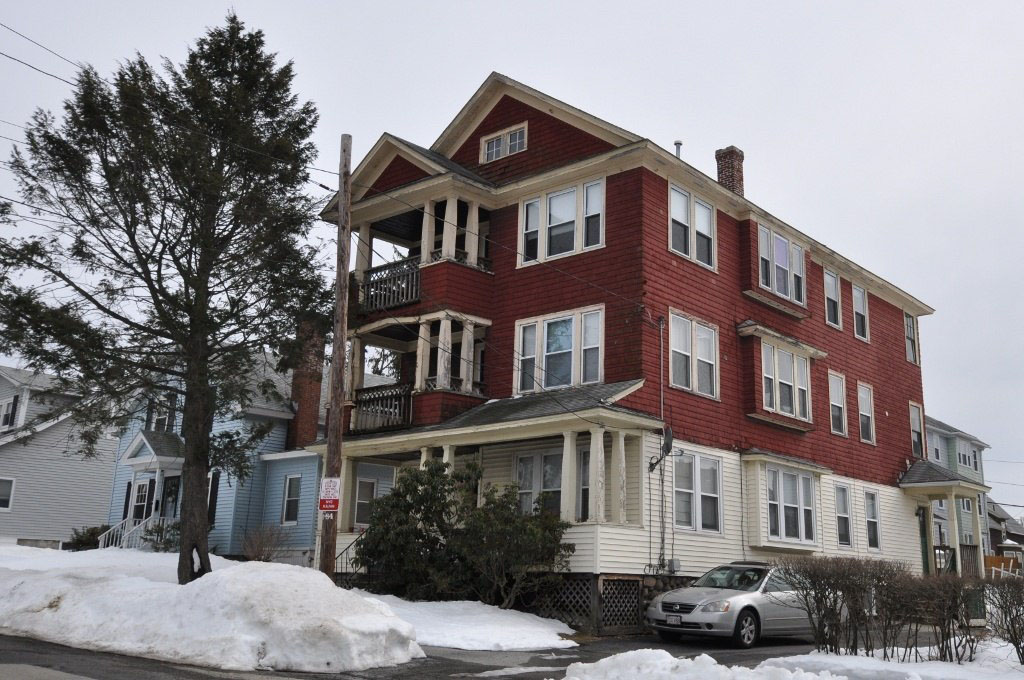
Inflation Reduction Act rebates, grants and tax incentives apply to owners of multifamily buildings as well as single-family homes. Depending on your renters’ incomes, some rebate and grant programs could cover 100% of project cost for energy saving upgrades. Image: CC BY-SA magicpiano.
We quote heavily from IRA text below, for utmost accuracy. Read the entire text of the law here. (For quick reference, you could search for references to “multifamily” or “multifamilies.”)
Sec. 50121 (c), titled “Home Energy Performance-based, Whole-house Rebates,” outlines the HOMES rebate program (HOMES stands for Home Owner Managing Energy Savings). The HOMES program distributes federal funds to state programs to provide rebates for whole-house energy retrofits. Retrofits refer to upgrades to the home, including the purchase and installation of electric heat pump water heaters, electric heat pumps for space heating and cooling, electric stoves, cooktops, ranges or ovens, electric heat pump clothes driers, electric load service centers, insulation, air sealing and ventilation improvement, and electric wiring.
References to Multifamilies
To be specific, Sec. 50121 paragraph (c)(2)(b) designates eligibility “for multifamily building owners and aggregators carrying out energy efficiency upgrades” at three levels: i) retrofits that achieve savings of between 20% and 35% are eligible for rebates of “$2,000 per dwelling unit, with a maximum of $200,000 per multifamily building”; ii) retrofits that achieve savings over 35%, “$4,000 per dwelling unit, with a maximum of $400,000 per multifamily building”; or iii) “for measured energy savings…a multifamily building or portfolio of multifamily buildings” achieving savings of at least 15% will be eligible for rebates that are measured per kilowatt hour saved.
The law continues to designate rebates for owners of multifamily buildings in which at least 50% of rental units are occupied by low- or moderate-income households (defined below). For retrofit energy savings of 20% to 35%, rebates equal the lesser of $4,000 per dwelling, or 80% of project cost. For retrofit energy savings of more than 35% in such buildings, rebates are set at $8,000 per unit or 80% of project cost, whichever is lower. For energy savings of at least 15% at multifamilies or a “portfolio of multifamilies,” rebate payments will be measured by kilowatt hour saved, or kilowatt hour-equivalent saved. This equals $2,000 for a 20% reduction of energy use per unit for an average multifamily, or 50% of project cost.
The law defines low- or moderate-income households as “an individual or family the total annual income of which is less than 80% of the median income of the area” (AMI), as defined by HUD.
That percentage would cover many renters in Massachusetts. Consider Worcester, for one example. According to the most recent U.S. census for the city of Worcester, covering 2017 to 2021, AMI in the city was $56,746, with 80% equaling $45,396. In Boston, AMI for the same period was $81,744, with 80% AMI equaling $65,395.
Further multifamily provisions
Sec. 50122 of the IRA, “High-efficiency Electric Home Rebate Program,” also includes provisions for multifamilies, with more robust rebates available. This section appropriates more than $4.2 billion to be distributed to state energy offices and Native American tribes for the purpose of supporting or developing grant and rebate programs for energy upgrades.
Subsection (c)(4)(B) outlines rebate ranges for upgrades to appliances and energy systems: 50% of project cost “for a multifamily building not less than 50 percent of the residents of which are households the annual income of which is not less than 80 percent and not greater than 150 percent of the area median income”; and 100% of project cost “for a multifamily building not less than 50 percent of the residents of which are households the annual income of which is less than 80 percent of the area median income.”
To translate: using 2021 data, if your Worcester renters make between $45,000 and $85,000, you can complete energy upgrades in their units and receive a rebate for 50% of the cost of the project. If your Boston renters’ household income is less than $65,000, you could receive a rebate or grant fully covering the project cost.
Eventually, grants at point of purchase will also be available
IRA also for multifamilies
The IRA contains 18 references to multifamily buildings, carefully designating their eligibility, alongside single-family homes, for program rebates, grants and tax incentives for energy upgrades.
These IRA benefits for energy upgrades will remain effective through 2032. How they will be distributed among states, and which state programs will administer rebates and grants, is yet to be determined. (We will continue to monitor and report on progress and implementation of this law.)
But to be certain, the IRA did not exclude landlords and owners of multifamilies, and the next decade might be the optimal time to convert your rentals to electric heating and cooling, water heating, cooking and upgrading to new wiring.
Mass. Goal: Net Zero Emissions
With Governor Baker’s signing of a state climate and clean energy bill in August 2022, Massachusetts took another step closer to net zero emissions by 2050. A major part of that goal will include transitioning nearly 3 million homes across the state from oil and gas heating and cooking appliances to electric, including heat pumps and electric stoves.
As a check point, the state aims to reduce its emissions by 50% by 2030. It’s an ambitious goal, made more challenging by supply shortages and demand surpassing the pool of trained installation contractors. As a result, some homeowners may find themselves waiting several months for heat pumps and installation. The U.S. Department of Energy is setting aside funding to explore ways to ramp up heat pump manufacturing in the U.S. It is also exploring ways to bolster the labor pool for installation of heat pumps and other energy efficiencies.
Other consumers report no complications with accessing heat pump supplies and scheduling installations. Now or later, the IRA presents landlords with an opportunity to save substantially on energy costs for rentals while reducing carbon footprints.
IRA Incentives for Electric Cars
Some landlords may also be affected by the IRA’s tax incentives for the purchase of designated electric cars.
A $7,500 tax credit has been in place for individuals who purchase certain new electric vehicles. However, the IRA has extended that incentive until 2032 and added a $4,000 credit for the purchase of used electric vehicles. It also added income caps for eligibility for the tax incentive, and stipulates that, beginning in January 2023, eligible vehicles must have battery components and minerals manufactured in the United States, and final car assembly must take place in the U.S. The Department of Energy lists eligible vehicles for tax incentives.
The IRA also extended tax credits for individuals or businesses to install EV charging stations, based on specific conditions.
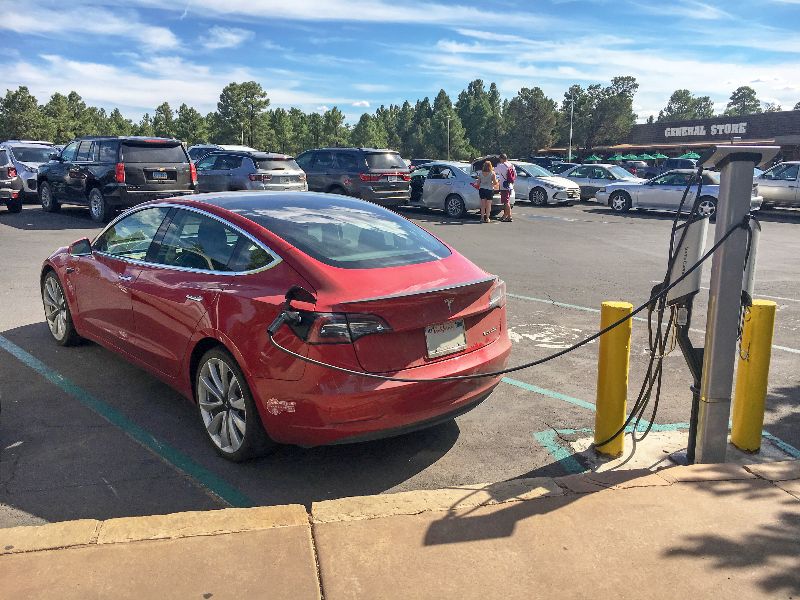
Electric vehicle charging stations like this one will become the norm as EV sales increase over the next decade and beyond, eventually replacing gas stations. Image: cc by-sa flickr
EVs the Coming Norm
How landlords navigate laws around climate change and the national transition to electric vehicles over the coming decade could make a substantial difference in revenue and overhead costs. By taking advantage of tax incentives built into the IRA before they expire, landlords could save tens of thousands of dollars or more.
For property owners who employ a sizable staff and provide company cars, transitioning to electric vehicles could be costly without tax breaks. When to begin that transition is up for question. Prices of electric cars will likely continue to come down as demand continues to grow. One estimate has electric cars and gas-powered cars pulling even in price by 2025.
Electric vehicles will become the norm in the near future. Massachusetts aims to halt the sale of gas-powered cars by 2035. This means your renters will be buying electric cars in coming years, and homes will increasingly need to have EV charging stations. (Public charging stations will quickly increase in number as more EVs are sold. But by most accounts, public EV charging stations will struggle to keep up with demand for some time. Home charging stations will offer the best option for efficiency and convenience.)
The IRA offers an opportunity to get a jumpstart on the EV transition by installing charging stations now and offsetting some of the cost with tax incentives. Early on, before home charging stations become the norm, rentals with that facility can present it as an added perk.
IRA Compromise: Continuation of Lower Carried Interest Tax Rate
Another provision in the IRA is the continuation of the capital gains tax rate for carried interest. This will purportedly lend a big-picture assist with housing development by providing an incentive for investment.
Carried interest refers to the percentage gained by an investment that is paid to a fund manager as compensation. Managers of hedge funds and private equity investments can earn massive gains as carried interest, based on a percentage of profits gained on the investments they oversee. This compensation is currently taxed as capital gains, at a top rate of 20%. Compared with the top individual federal tax rate of 37%, that can have a sizable impact on investment profit-based payouts.
The original version of the IRA sought to eliminate this controversial tax loophole, which allows some hedge fund and private equity managers to pay a lower tax bill on their profit-based compensation (in many cases, a lower rate than their employees).
The IRA also proposed to extend the period an investment firm must hold an investment from the current three years to five years in order to be eligible for carried interest definition and tax rate. To gain the support of Senator Kyrsten Sinema (I-Ariz.), Schumer and Manchin agreed to strike the loophole elimination from the bill and retain the three-year hold requirement on investments.
Democratic lawmakers have long sought to change the carried interest tax loophole, and to tax hedge fund and private equity managers’ compensation as earned income at higher rates. The change would mean billions of dollars in extra tax revenue for the federal government (private equity firms control more than $6 trillion in U.S. assets), mostly from those who can well afford it. But it could also have a dampening effect on housing investment. Private equity provides most of the financial support to the largest corporate owners of multifamily buildings, according to analysis by ProPublica.
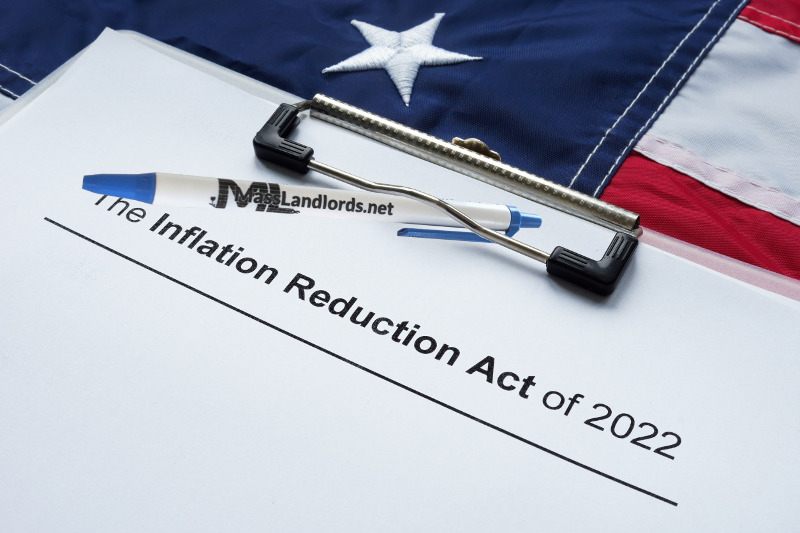
The Inflation Reduction Act offers substantial green energy incentives for owners of Massachusetts real estate. Derivative of Licensed 123rf.
IRA An Opportunity for Landlords
The IRA is a vital piece of legislation for landlords. It provides a financial bridge now and over the next 10 years for upgrading to future energy production and efficiency. Electric heating and cooking will eventually become the status quo for all homes and buildings.
The national (and worldwide) transition to non-fossil fuel forms of energy is, and will be, costly. As owners of homes and buildings reliant on energy systems, landlords will bear a sizable share of that cost. Renters may also share the burden in the form of rent increases to help cover energy upgrades to their dwellings.
Waiting to renovate rentals for more efficient energy production is a risky prospect. True, costs of solar panels and other renewable energy equipment might continue to come down. But the cost of oil, gas and energy purchased from utilities are likely to keep increasing. Also, as the clamor for heat pump and solar contractors builds, labor prices for their services will probably increase accordingly.
The time for considering or taking steps to leave behind fossil fuels for electric HVAC, water heating, cooking appliances, vehicles, solar and other renewable energy production is now, or soon. By taking advantage of the menu of incentives and rebates written into the IRA, the bill for transitioning to more efficient energy systems can be greatly reduced, saving collective billions for landlords and renters.



